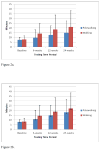Comparison of walking with poles and traditional walking for peripheral arterial disease rehabilitation
- PMID: 22595894
- PMCID: PMC3389570
- DOI: 10.1097/HCR.0b013e31825828f4
Comparison of walking with poles and traditional walking for peripheral arterial disease rehabilitation
Abstract
Purpose: The purpose of this study was to compare the effects of a 24-week walking with poles rehabilitation program with a traditional 24-week walking program on physical function in patients with peripheral arterial disease (PAD).
Methods: Patients with PAD (n = 103, age = 69.7 ± 8.9 years, ankle-brachial index < 0.90 or evidence of calcified vessels) were randomized into a rehabilitation program of traditional walking (n = 52) or walking with poles (n = 51). Patients exercised 3 times per week for 24 weeks. Exercise endurance was measured by time walked on a constant work rate treadmill test at 6, 12, and 24 weeks. Perceived physical function was measured by the Medical Outcomes Study Short Form-36 and Walking Impairment Questionnaire. Tissue oxygenation was measured using near-infrared spectroscopy.
Results: Patients assigned to the traditional walking group walked longer at 24 weeks than those assigned to the pole walking group (21.10 ± 17.07 minutes and 15.02 ± 12.32 minutes, respectively, P = .037). There were no differences between the groups in tissue oxygenation. However, there was a significant lengthening of time for which it took to reach minimum tissue oxygenation values (P < .001) within the groups on the constant work rate test. There were no differences between the groups in perceived physical function as measured by the Physical Function subscale on the Medical Outcomes Study Short Form-36 or perceived walking distance as measured by the Walking Distance subscale on the Walking Impairment Scale.
Conclusions: Traditional walking was superior to walking with poles in increasing walking endurance on a constant work rate treadmill test for patients with PAD.
Figures


References
-
- Gardner AW, Poehlman ET. Exercise rehabilitation programs for the treatment of claudication pain. A meta-analysis. JAMA. 1995;274:975–980. - PubMed
-
- Wilson JTM, Decker MJ, Kernozek T, Steadman JR. Effects of walking poles on lower extremity gait mechanics. Med Sci Sports Exerc. 2001;33:142–147. - PubMed
-
- Langbein WE, Collins EG, Orebaugh C, et al. Increasing exercise tolerance of persons limited by claudication pain using Polestriding. J of Vascular Surgery. 2002;35:887–895. - PubMed
-
- Collins EG, Langbein WE, Orebaugh C, et al. Polestriding exercise and vitamin E for management of peripheral vascular disease. Med Sci Sports Exerc. 2003;35:384–393. - PubMed
-
- Ware JEJ. [Accessed May 24, 2003];2003 2003 www.qualitymetric.com/demos/SF-36v2.html.
Publication types
MeSH terms
Grants and funding
LinkOut - more resources
Full Text Sources
Medical

